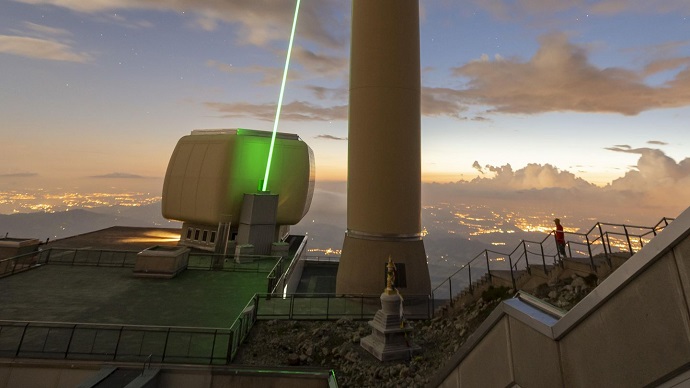
Giant Terawatt Laser Takes Aim at Lightning Strikes from Atop Swiss Alps
DITZINGEN, Germany, July 21, 2021 — TRUMPF reports that the first experiments in the EU Laser Lightning Rod (LLR) project, in collaboration with the University of Geneva, are complete. The project uses a high-repetition terawatt laser that the collaborators have placed at the top of Säntis, a mountain in the Swiss Alps that houses a radio transmission tower.
The researchers aim to use the laser system to conduct a series of weather experiments and, specifically, control lightning from storm clouds and direct the strikes to places where they will not cause damage.

The green beam of the TRUMPF laser is clearly visible during use. It reaches infinitely far into the sky. Courtesy of TRUMPF/Martin Stollberg.
Described as a “super” laser, the TRUMPF laser used in the project is more than 29.5 ft long and weighs around 5 tons. The laser creates a kind of channel through the storm clouds, known as a laser filament. When a lightning discharge occurs, the laser filament ensures the lightning follows the channel and strikes the ground in a controlled manner.
The laser will be directed to the top of the tower — more than 400 ft tall — to guide the lightning and create a laser lightning rod that extends far into the sky beyond the conventional lightning rod at the top. Lightning measurement instruments operated permanently at Säntis, together with an interferometric lightning mapping array and high-speed cameras, will provide lightning diagnostics. The laser’s beam is intended to run alongside the tower.
“The laser lightning rod is currently one of the most powerful lasers in its class,” said Clemens Herkommer, a laser engineer for TRUMPF who has spent the last four years developing the laser system.
“By shooting a thousand laser pulses a second into the clouds, we can safely discharge the lightning and make the world a little bit safer,” he said.
Airports, nuclear power plants, skyscrapers, and forests are regularly hit by lightning. In the U.S. alone, storms and lightning strikes cost the economy $5 billion a year, mostly through disruption to air traffic and damage to aircraft and power lines.
Now assembled at Säntis, the laser is expected to encounter hundreds of lightning bolts. That amount reportedly strikes Säntis during peak thunderstorm activity in June, July, and August alone.
The project is led by University of Geneva researcher Jean-Pierre Wolf. With experiments now underway, he and his partners expect to have some preliminary results by the end of the summer.
Additional collaborators on the EU-funded consortium include those from the French National Centre for Scientific Research, AMC Consultants, the Swiss Federal Institute of Technology Lausanne, ArianeGroup, and the University of Applied Sciences and Arts of Western Switzerland.
/Buyers_Guide/TRUMPF_SE_Co_KG/c15241